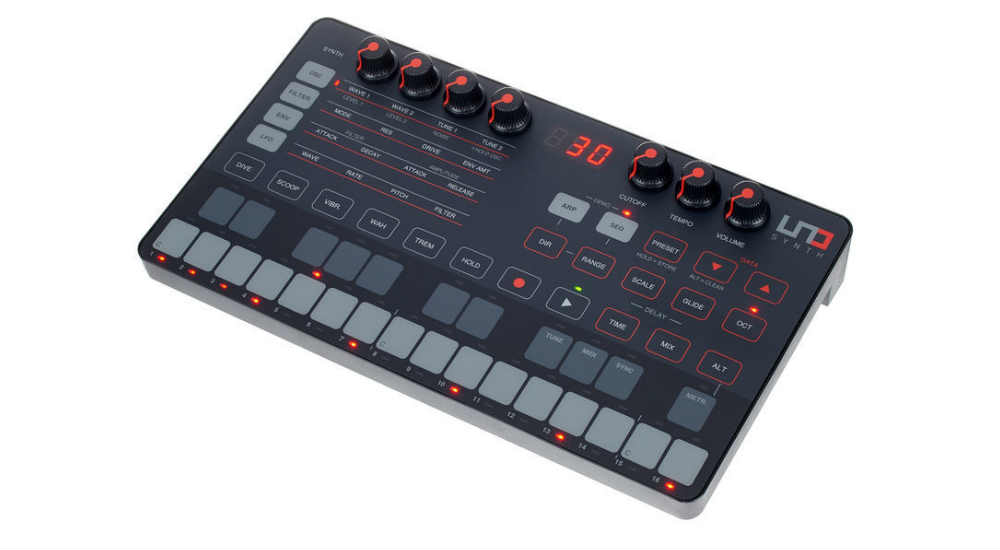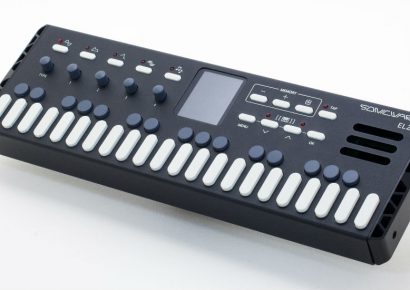Despite the abundance of heavyweight competitors, Italian audio tech firm IK Multimedia has also decided to throw its hat into the ring with their own take on the analogue trend with the small, yet oh so mighty, UNO.
Weighing in at a slight 400 grams and taking up less space than the average iPad, the UNO is an ultra-portable, two oscillator mono synth packed with a sequencer, arpeggiator and an array of real-time effects. Power is provided either via micro USB or four AA batteries, making the UNO perfect for musicians on the go or to fiddle with in transit. I’m sure some will fuss about IK’s decision to add 3.5mm input and output ports on the rear of the unit, but it’s obviously a nifty cost-cutting measure that also complements the portability of the synth. While its name bears semblance to a relatively famous polysynth of the ‘80s, the UNO follows in the footsteps of none, offering a completely unique approach in its sound, function and design. Given IK Multimedia’s main hustle is within the digital realm of interfaces and iOS apps, this decision is definitely for the better, making playing with the UNO an invigorating experience.
Avoiding the typical analogue trope of crowding as many knobs, switches and faders onto the interface as possible, the UNO’s synth engine is instead controlled by four rotary knobs and soft touch buttons arranged into one easy matrix. With two independent VCOs providing sawtooth, triangle, square and variable pulse waveforms, a noise generator, a two-pole filter with LPF, BPF and HPF modes (there’s also a dedicated filter cutoff knob, which is a big win in my books), an LFO and a custom dual-stage overdrive, you’ll be flummoxed with the amount of sounds you can squeeze out of the UNO. Whether you’re aiming for snarling acid house tones, rumbling Moog bass, sharp sawtooth leads or something weird and wacky, you’ll be able to wrangle it from the UNO with ease. There’s also 100 presets (80 of which are customisable) to choose from to get you started with patch building, which is actually quite impressive considering the size of the device. However, given the same kind of soft touch buttons in the editing matrix are used to control the keyboard of the synth, you’ll want to plug a MIDI keyboard into the UNO straight away to really access its full potential otherwise you’ll be stuck in sequencer land.
If being stuck in sequencer land doesn’t sound too bad to you, then you’ll still be able to have plenty of fun with the UNO. Recording and editing sequences is simple and intuitive, and if you’ve ever played around with any model from the Korg Volca series, you’ll be able to master the UNO’s 16-step sequencer pretty easily. Sequences can be programmed in steps or in real time with three directions to choose from: forwards, backwards or back-and-forth, while tempo can be tweaked via a dedicated rotary knob. The UNO’s arpeggiator is also surprisingly powerful with ten patterns, a four-octave range and a convenient hold function to keep things rolling on even when you’re editing sounds. There’s also an inbuilt analogue delay located near the right side of the keyboard which adds a whole lot of character to any sequence or arpeggio you’re playing, as well as a range of other performance effects including Dive, Scoop, Vibrato, Wah and Tremolo. Save for the delay, these effects really don’t add anything to the experience of the UNO, and sound like they’ve been shipped across from a quirky ‘90s multi-effects pedal.
Given the power, performance, portability and price tag of IK Multimedia’s first foray into the world of analogue synths, I’m surprised at the lack of hype around this little fella, because the UNO has serious potential to put a big dent in the budget synth market. It’s an incredibly inspiring unit with an easily navigable interface and array of sounds to choose from, and is bound to offer just as much fun to synth masters as it does to beginners.

